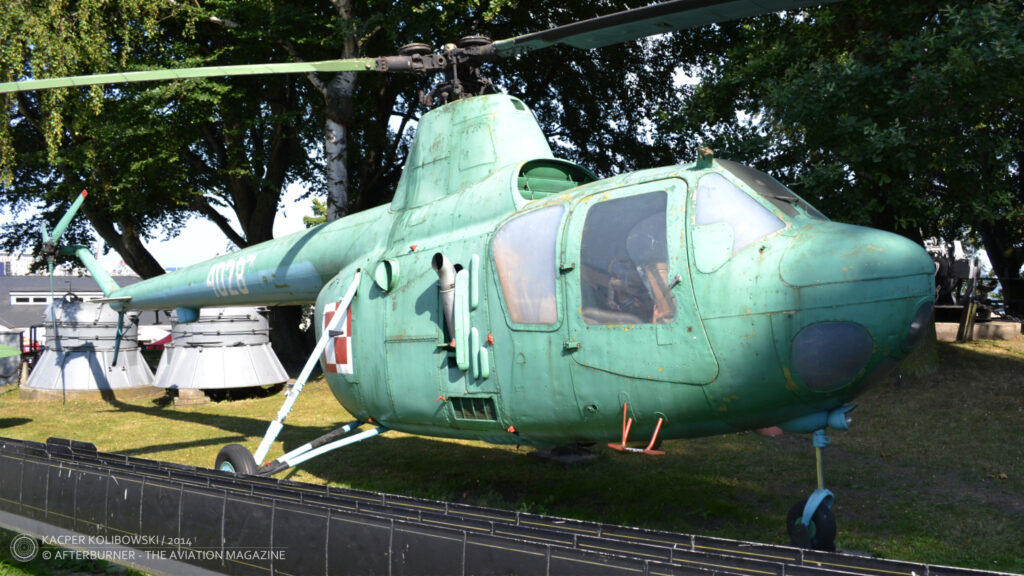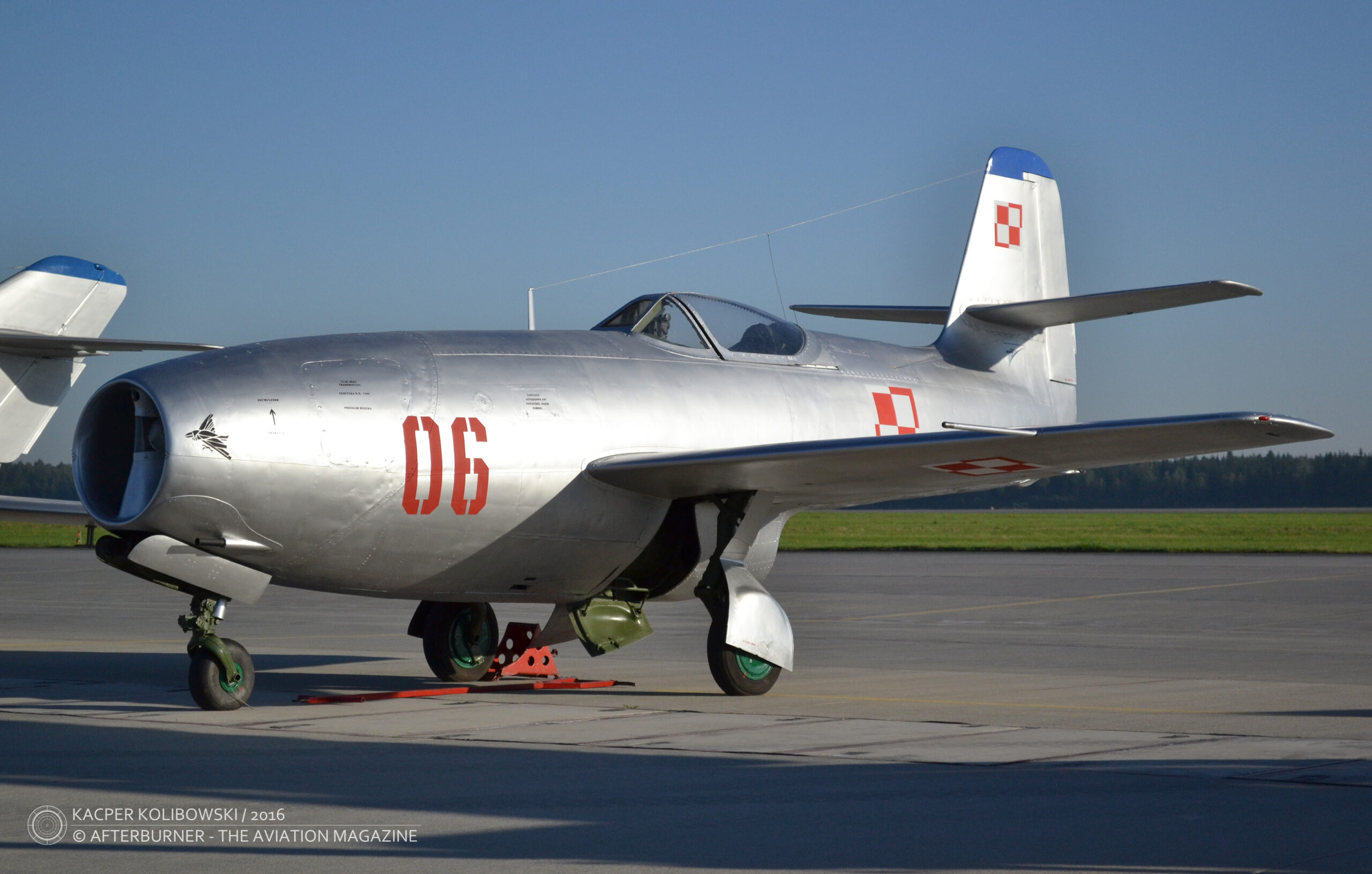 WSK SM-1Sz (c/n not confirmed – probably 402017, formerly ´4028´ of the Polish Air Force), exhibited at Museum of the Polish Navy, Gdynia, July 2014.
WSK SM-1Sz (c/n not confirmed – probably 402017, formerly ´4028´ of the Polish Air Force), exhibited at Museum of the Polish Navy, Gdynia, July 2014.
The SM-1 helicopter is a Polish, licensed version of a Soviet Mil Mi-1 rotorcraft that was developed in the late 1940s and introduced into operational service in 1950. The Polish variant was manufactured between 1956 and 1965, by Wytwórnia Sprzętu Komunikacyjnego (WSK) Świdnik (English: Communication Equipment Factory in Świdnik). The first example of the new rotorcraft was flown in the mid-1956 and then, on 26th August of the same year, already four SM-1 helicopters were for the first time officially presented to general public, during an air show held at Okęcie Airport in Warsaw.
Although manufacturing of the SM-1 in Poland was commenced in the first half of 1956, the first helicopters were yet Soviet-made Mi-1T, delivered in parts for final assembly in Świdnik. The entirely domestic production was launched in the following year and the first Polish-made examples received official designation SM-1/300 – the latter digit represented number of flight hours between main rotor overhauls.
At the end of 1957, one of the SM-1 examples – registered SP-SAD – was handed over to the Aviation Institute in Warsaw for research purposes. A series of tests performed on that helicopter included possibility to use the SM-1 for glider towing, as well as lifting gliders into the air with use of external sling.
Apart from the abovementioned tests, the Aviation Institute also set a few aviation records with the SM-1 helicopter. On 5th September 1957, Ryszard Witkowski climbed the rotorcraft to an altitude of 3,000 metres in 468 seconds (462 seconds, according to other sources), thus setting the then international record in this category. Just two days later, Stanisław Gajewski beat the fresh record by clocking even better time of 423 seconds.
In 1958, production of SM-1/600 with increased main rotor service life was commenced, based on original Mi-1A variant of the helicopter. In addition, due to increasing domestic interest and demand for helicopters, a decision was made at the design office of WSK Świdnik to develop further versions of the helicopter. That task was assigned to a team of aeronautical engineers led by Jerzy Olejnik.
As a result of the aforementioned development, the following variants of the rotorcraft were created: SM-1D – equipped with an on-board winch allowing to pick up personnel from the ground; SM-1S medical helicopter allowing to carry two sick or injured persons by using two external pods mounted on both sides of the fuselage; SM-1Sz training version with a doubled control system; and finally SM-1Ż agricultural variant equipped with tanks for chemicals and crop dusting apparatus.
In 1960, a multi-role version of the helicopter, designated SM-1W and based on Mi-1M, entered serial production. It differed from the previous variants, having upgraded main rotor blades and more modern radio navigation equipment. The SM-1W was primarily used for liaison, passenger, medical and agricultural purposes.
Then, in 1963, another variant of the helicopter was introduced. It was designated SM-1Wb and had the rotor blades service life extended to 800 flight hours.
Operational history of the SM-1 helicopters in Poland is closely related to their service in Polish armed forces. The rotorcraft were introduced into the then Polish People’s Army Air Force in 1956, becoming the first helicopters in the history of Polish military aviation. During their initial years of service, the SM-1 were performing dispatch, liaison and air patrol duties.
In 1957, the SM-1 helicopters were assigned to the 36th Special Independent Aviation Regiment in Warsaw. It meant significant change of their role in Polish aviation as the rotorcraft were increasingly used for a broad range of new duties. They were performing photogrammetric flights, were used to crush ice jams with explosives and evacuating people from flooded areas. What´s more, several pioneering tasks were also assigned to the SM-1 helicopters during their service in the 36th Regiment – the first helicopter landing on the roof of the Grand Hotel in Warsaw, providing broadcasting services during the annual Peace Race cycling event, as well as being used for aerial shots during making the then Polish blockbuster movie ‘Krzyżacy’ (English: The Teutonic Knights).
In 1961, the SM-1s were introduced into service with the 24th Independent Frontline Communications Squadron and, in subsequent years, also with the 1st National Air Defence Corps, the 47th Helicopter Training Regiment, the 24th Independent Liaison Aviation Squadron, the 27th Medical Aviation Squadron and the 28th Naval Rescue Squadron. In addition, the SM-1 rotorcraft also served in Wojska Ochrony Pogranicza (English: Border Protection Troops), where they were being used for patrol flights along the Polish borders.
In the mid-1960, the SM-1 helicopters began to be withdrawn from the service in the Polish aviation and were gradually being replaced with newer and more capable Mi-2 rotorcraft. Nevertheless, they were still used for training purposes in military aviation in the 1970s, and finally ended their operational service in 1983.
Between 1956 and 1965, approximately 1,600 examples of the SM-1 were manufactured by WSK Świdnik. They were being used not only by domestic civilian and military operators but also exported to several countries of the Eastern Bloc, as well as to Austria, Afghanistan, Brazil, Egypt, Finland and Indonesia.
About ten examples of the SM-1 helicopter have survived to this day in various Polish museums or in a role of aviation memorials. Among them there is the WSK SM-1Sz pictured above, exhibited at Museum of the Polish Navy in Gdynia. That particular example was, most probably, manufactured as the SM-1Wb, then re-built to the training version SM-1Sz. Its construction number is not confirmed, just like the tactical number.
Source: Jerzy Grzegorzewski, Śmigłowiec Mi-1, Wydawnictwo MON, 1976



